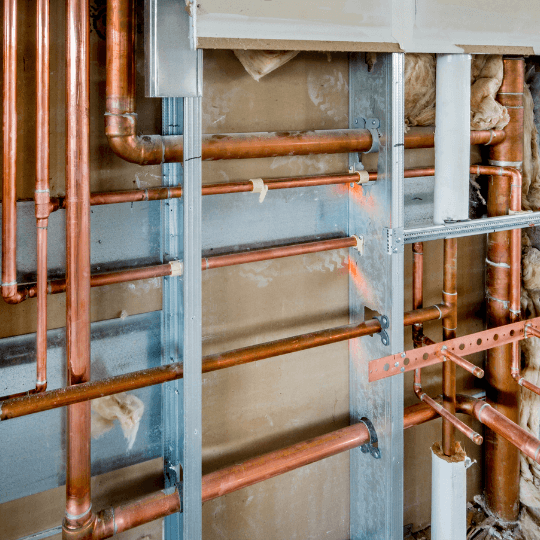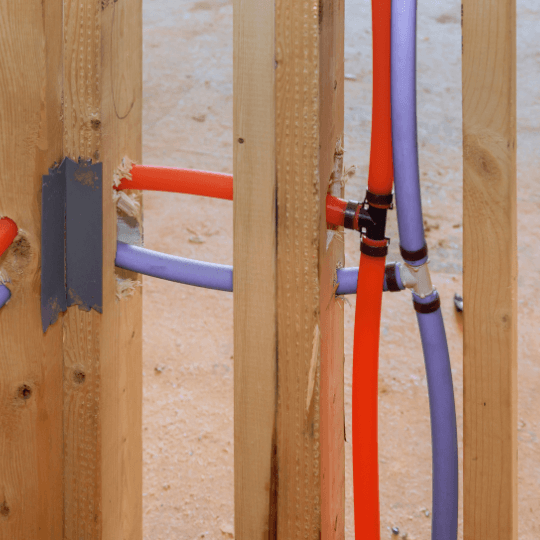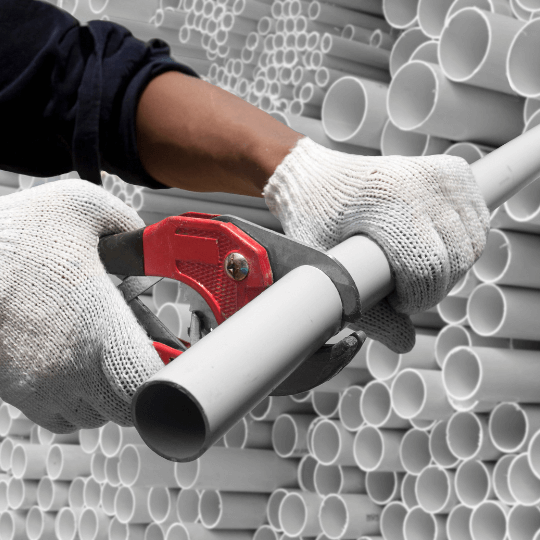Choosing the right type of plumbing is essential in home restorations, not only for the functionality and reliability of your water systems but also for increasing the property’s value.
Selecting the appropriate plumbing materials and layout that align with the building’s requirements can prevent future problems and additional expenses.
Understanding the differences between the various plumbing systems can guide renovators in making decisions that ensure longevity and efficiency.
With these considerations in mind, let’s delve into the three primary types of plumbing and determine which might best suit a renovator’s specific requirements.
Type 1: Traditional Plumbing
Traditional plumbing, also known as conventional plumbing, primarily involves the use of copper pipes and fittings.

This system has been utilized for decades due to copper’s durability and its natural ability to resist bacteria.
Historically, traditional plumbing set a high standard for reliability and was indispensable in ensuring the safe distribution of potable water in residential homes and commercial buildings.
Pros:
- Durability: Copper pipes are known for their longevity and resistance to corrosion.
- Antimicrobial properties: Copper naturally combats the growth of harmful microbes.
- Heat resistance: The material is capable of withstanding high temperatures, making it ideal for hot water supply lines.
Cons:
- Cost: Copper is typically more expensive than other materials.
- Installation: Requires professional installation involving soldering, which can be labor-intensive.
- Corrosion: In some cases, copper can still corrode over time, particularly in acidic water conditions.
Suitable Applications:
For homeowners or renovators looking to invest in a proven, time-tested plumbing system and not constrained by budget, traditional copper plumbing is a robust option.
It is particularly well-suited for areas with a known history of water quality issues, as its properties can help maintain the purity and safety of the water supply.
Type 2: PEX Plumbing
PEX plumbing, or cross-linked polyethylene plumbing, has rapidly gained popularity as a modern alternative to traditional plumbing solutions. Due to its versatility and flexibility, PEX plumbing simplifies the installation process and significantly reduces material costs.

Pros:
- Flexibility: PEX pipes can be easily bent around corners, eliminating the need for numerous fittings and reducing potential leak points.
- Cost-effectiveness: Less expensive than copper and requires fewer tools and labor for installation.
- Durability: Resistant to scale and chlorine, PEX does not corrode or develop pinhole leaks as copper does.
- Energy efficiency: PEX systems minimize heat transfer, conserving energy in hot and cold water applications.
Cons:
- UV Sensitivity: PEX materials can degrade when exposed to sunlight, requiring careful storage and handling.
- Permeability: Certain types of PEX may allow the infiltration of contaminants from the external environment into the water supply.
Suitable Applications:
PEX is ideal for new home constructions and renovation projects, particularly where cost savings and ease of installation are priorities.
Its flexible nature makes PEX suitable for retrofitting older homes with minimal disruption to existing structures.
PEX’s heat preservation capabilities are advantageous in regions with extreme temperatures, contributing to the overall efficiency of the home’s heating and cooling systems.
Type 3: PVC Plumbing
- Definition and uses of PVC plumbing
- Its role in modern homes
- Advantages and disadvantages
- Special considerations for property upgrades
Factors to Consider for Home Renovations When it Comes to Types of Plumbing
When planning home renovations, it’s essential to consider the water pressure and flow requirements for different plumbing types.
Residential areas often have specific codes regarding water pressure, and selecting a pipe like PEX, which can expand and contract, can help maintain consistent water flow.
In contrast, PVC is more rigid, providing steady pressure but potentially responding differently to varying water demands.

Durability and expected lifespan are also crucial factors.
PEX plumbing can last 25-50 years or more, depending on use and environment, while PVC pipes can have a lifespan of up to 100 years in optimal conditions.
However, these timelines can be shortened by factors such as high chlorine levels and ultraviolet exposure.
Maintenance and repair costs vary.
PEX is known for its low-cost maintenance. Its resistance to scale and corrosion reduces the likelihood of leaks.
PVC may require more frequent checks, especially at connection points, but is relatively inexpensive to replace.
Another consideration is aesthetics—plumbing isn’t just functional but also contributes to a home’s overall design.
PEX’s flexibility allows for cleaner lines and less visible hardware within walls, while PVC’s rigidity may require more strategic planning to maintain a property’s design integrity.
In summary:
- Water Pressure and Flow: PEX provides flexibility and resists changes in water pressure, while PVC offers rigidity and consistent flow.
- Durability and Lifespan: PEX lasts 25-50 years, with PVC potentially lasting up to 100 years.
- Maintenance Costs: PEX generally has lower lifetime costs, while PVC may need more frequent checks.
- Aesthetics: PEX can be more easily hidden within walls for a cleaner look, whereas PVC may affect design but can be planned around for visual appeal.
Enhancing Property Value with the Right Type of Plubming
In the real estate market, the type and quality of a home’s plumbing system play a crucial role in its appeal to potential buyers.
A superior plumbing system promises everyday comfort and safety for residents and indicates that the property has been attentively maintained.
Research indicates that homes equipped with contemporary plumbing systems can achieve higher resale values, especially those that incorporate energy-efficient and sustainable plumbing technologies.
PEX Plumbing: The Modern Choice for Efficiency and Durability
PEX (cross-linked polyethylene) plumbing is at the forefront of plumbing innovation, offering significant benefits in terms of durability and energy efficiency.
Its flexibility allows for easier installation and fewer joints, reducing the potential for leaks.
PEX is also highly resistant to corrosion and scale buildup, making it a long-lasting option that can help homeowners avoid future repair costs.
PEX’s thermal retention properties reduce energy consumption, making it an eco-friendly choice that appeals to environmentally conscious buyers.
Properties featuring PEX plumbing are often viewed as more modern and sustainable, potentially increasing their market value.
Copper Plumbing: Traditional Reliability and Quality
Copper plumbing has been a standard of reliability and quality for decades.
Its longevity, resistance to bacteria, and ability to withstand extreme temperatures make it a durable choice for a home’s plumbing infrastructure. Copper’s recyclability adds an eco-friendly aspect that can appeal to buyers interested in green living.
Although copper plumbing systems may come with a higher initial cost, their durability, and minimal maintenance requirements can make them a valuable investment, enhancing a property’s value by assuring potential buyers of the quality and stability of the plumbing system.
PVC Plumbing: Versatility and Cost-Effectiveness
PVC (polyvinyl chloride) plumbing offers a versatile and cost-effective solution suitable for drain lines and wastewater systems. It is resistant to corrosion, chemicals, and rust, ensuring a long service life with minimal maintenance.
PVC’s affordability makes it an attractive option for homeowners looking to upgrade or repair their plumbing systems without significant expense.
While PVC might not boost property value to the same extent as PEX or copper, its practical benefits and functionality can still contribute positively, especially in areas susceptible to high moisture levels or corrosive materials.
Leveraging Plumbing for Property Value
For homeowners and real estate professionals, emphasizing the advanced plumbing technologies used in a property can be a strategic selling point.
Highlighting energy-efficient features like low-flow fixtures and the environmental benefits of sustainable plumbing solutions can attract eco-conscious buyers.
Stressing the durability and energy-saving advantages of systems like PEX can appeal to buyers looking for homes that minimize environmental impact and future repair costs.
Final Thoughts
Selecting the right plumbing system—whether it’s the robust copper, versatile PEX, or cost-effective PVC—is crucial for elevating your home’s functionality, efficiency, and appeal in the market.
Each option brings unique advantages that can dramatically enhance the value and attractiveness of your property.
Ready to transform your home with a plumbing upgrade that promises lasting value? Don’t wait. Contact AC Pros Plumbing Services today and discover how our expert solutions can set your property apart.
